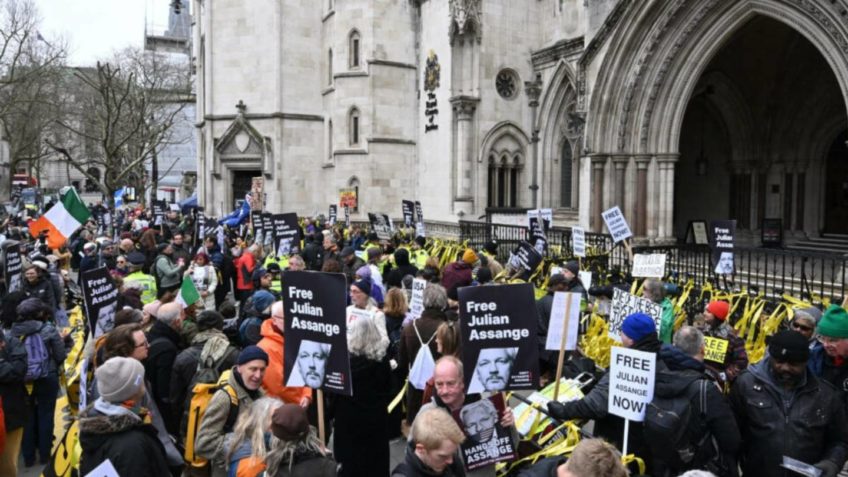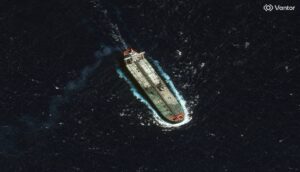
The hearing of the Australian journalist, imprisoned since 2019, was held on Tuesday and Wednesday (Feb. 20 and 21, 2024)
The extradition trial of the founder of WikiLeaks, Julian Assange, had another chapter in a hearing held on Tuesday and Wednesday (Feb. 20 and 21, 2024), at the Supreme Court of the United Kingdom. The judges, however, should take around 1 month to announce the decision.
Arguing health problems, Assange did not appear in court. Outside, representatives of the WikiLeaks and supporters gathered to watch the trial. They carried signs of support and Australian flags, while chanting “free Julian Assange” e “just one decision, no extradition”.
Judges Victoria Sharp and Jeremy Johnson will deliberate on a June 6 British Supreme Court ruling in which an appeal against Assange’s extradition order to the United States was denied.
The journalist faces 18 charges under the US Espionage Act for disclosing secret documents containing information on diplomatic and military activities. The data deals with the period known as the War on Terror, a military campaign promoted by the country in response to the September 11 attacks.
According to US lawyers, Assange went beyond journalism by indiscriminately obtaining and publishing classified government documents. Lawyer Clair Dobbin stated on Wednesday (Feb 21) that Assange harmed US security and intelligence services and “created a serious and imminent risk” when releasing the documents. “Allegations are that he sought to encourage theft and hacking that would benefit WikiLeaks”, he added.
Assange’s supporters, on the other hand, claim he is a journalist who exposed US military wrongdoing in Iraq and Afghanistan. They argue that the accusation is politically motivated and that Assange will not receive a fair trial in the USA.
In the same vein, the journalist’s defense accused the US authorities of wanting to punish him for “exposure of criminality by the US government on an unprecedented scale”, including torture and murder. He also indicated “real risk“from your client”suffer a flagrant denial of justice” if shipped to USA,
Assange’s lawyers say he could face up to 175 years in prison if convicted in the US, although US authorities say the sentence is likely to be less.
According to Stella Assange, the activist’s wife, “Julian is a political prisoner and must be released”. She claims that if he is sent to the US, her husband “will remain in the hands of the country and the people who planned his murder”, in reference to unproven allegations that he was the target of a CIA (US Intelligence Agency) conspiracy.
If British judges rule against Assange, he could appeal to the European Court of Human Rights.
UNDERSTAND THE CASE
Julian Assange, 52, founded the site WikiLeaks in 2006. Starting in 2010, the Australian began publishing confidential information about the US. The North American government estimates that there were 700,000 documents.
The material, published in WikiLeaks and in other vehicles, such as The Guardian e The New York Times, contained data on the wars in Afghanistan and Iraq and other diplomatic and military operations information. They also reported information about the air attack on Baghdad (Iraq) in July 2007. Part of the documents were about alleged abuses committed by the US Armed Forces.
Julian Assange was arrested in London in 2019, in the high-security Belmarsh prison, after spending 7 years sheltered in the Ecuadorian embassy. He was trying to avoid being arrested and extradited to Sweden, a country where he was accused of 2 cases of rape. The investigation was later archived.
The leaks exposed human rights abuses and spying on leaders of other countries.
O Poder360 separated the main events regarding the case of the founder of WikiLeaks.
Here is the timeline:
- 2006: Assange funda o WikiLeaks and begins publishing classified information and news leaks from anonymous sources;
- August 2010: a Swedish prosecutor issues an arrest warrant after two Swedish women accuse Assange of rape and sexual abuse in separate allegations;
- November 2010: WikiLeaks starts to publicize diplomatic telegrams acquired from an anonymous source, prompting the US Department of Justice to open an investigation. The source is later discovered to be Chelsea Manning. Sweden also issues an international arrest warrant for Assange;
- December 2010: the Australian surrenders to the British police. The courts consider that he must post bail;
- May 2012: British Supreme Court rules in favor of Assange’s return to Sweden, but his lawyers ask for a delay;
- August 2012: Assange is granted asylum at the Ecuadorian Embassy in London, which cites concerns about human rights abuses if he is extradited. The journalist entered the embassy for the first time in June 2012;
- August 2015: Swedish prosecutors drop sexual abuse charges against Assange after they ran out of time to question him, but he still faces a rape charge;
- February 2016: the United Nations Working Group on Arbitrary Detention concludes that Assange was “arbitrarily detained” by Sweden and the United Kingdom since December 2010 and calls on both governments to end their “deprivation of liberty”;
- October 2016: Ecuador government says it cut off Assange’s internet due to the release of hacked emails WikiLeaks during the 2016 election – later revealed to be part of Russian government interference on behalf of then-candidate Donald Trump. Assange announced in December that his internet connection had been restored;
- April 2017: former director of the CIA (US Central Intelligence Agency) Mike Pompeo describes the WikiLeaks as a “non-state hostile intelligence service” that constitutes a threat to the national security of the United States;
- May 2017: Swedish prosecutors close 7-year investigation into rape allegation against Assange;
- December 2017: Ecuador grants citizenship to Assange in a failed attempt to give him diplomatic immunity;
- February 2018: British judge Emma Arbuthnot says the country will not drop charges against Assange after he cheated on bail in 2012 by seeking asylum at the Ecuadorian Embassy;
- April 2019: a week before Assange was arrested, the Ecuadorian president says he “He violated the agreement we made with him and his lawyer many times”. The information is from Washington Post;
- April 11, 2019: Assange is arrested on a US extradition warrant after Ecuador withdraws its offer of asylum. He is found guilty of not paying bail determined by the British Court;
- May 1, 2019: Assange was condemned almost 1 year in prison in the United Kingdom;
- May 23, 2019: US charges journalist under Espionage Act. He was indicted on 18 counts. The case raises questions about the First Amendment, which guarantees freedom of expression in the US;
- June 11, 2019: USA enter with an extradition request against Assange. Request was rejected in January 2021 due to the risk of the Australian committing suicide;
- October 28, 2021: USA try again obtain extradition of Julian Assange. The US government denied that the his mental health be fragile to the point that it cannot withstand the US judicial system;
- April 20, 2022: British justice issue extradition order for Assange to the US;
- June 17, 2022: United Kingdom approves extradition of journalist to the USA;
- June 6, 2023: United Kingdom Supreme Court rejects the last appeal presented by the journalist;
- June 13, 2023: Assange’s defense presents final appeal against extradition;
- February 14, 2024: Australian Parliament calls for Assange to be allowed to return to his homeland;
- June 20 and 21, 2024: trial of Assange’s last appeal in the British Supreme Court. The sentence should come out in about 1 month.
Source: https://www.poder360.com.br/internacional/decisao-sobre-extradicao-de-assange-deve-demorar-1-mes/

